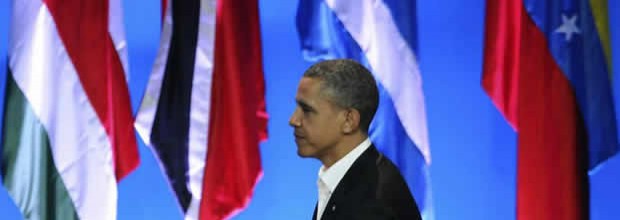
The CELAC, Cuba and Obama’s dilemma
HAVANA – Colombian President Juan Manuel Santos said, “There is no Final Declaration, because there is no consensus,” and those words rang lapidary, as if the first letters of an epitaph were being inscribed in marble. It was Sunday, April 15, 2012, and the closing ceremony of the Sixth Summit of the Americas was held in Cartagena de Indias.
Clearly, a rebellion had occurred throughout Latin America and the Caribbean when those nations rejected the vetoes of the United States and Canada to the paragraphs in the Final Declaration draft that demanded an end to the blockade against Cuba and Cuba’s exclusion from hemispheric events.
To many, this was the beginning of the end of these hemispheric summits, led by the United States, that began in Miami in 1994 with the express purpose of bringing — at one blow and swiftly — all the nations from Canada to Argentina, with the exception of Cuba, into the Free Trade Area of the Americas (FTAA).
It was no less than an attempt to absolute hegemony — to extend the North American Free Trade Agreement (NAFTA) between the U.S., Canada and Mexico to the rest of the countries in Latin America and the Caribbean.
Two decades have elapsed since the signing of the NAFTA and hundreds of articles have been written that explain the suffering experienced by the Aztec nation after its rulers accepted, without question, the neoliberal hegemony practiced by two countries that practice core capitalism.
Economist Alejandro Nadal summarizes the situation thus: “Mexican liberalism has three pillars: the NAFTA, the monetary and financial policy and the fiscal policy. That mixture explains why today we have 55 million Mexicans mired in poverty. And we’re not exaggerating when we say that Mexico became a protectorate of the United States. It economic, energy and foreign relations policies are defined in Washington.”
The plan to extend throughout the region the experience of the NAFTA, presented as an example to be imitated, could not be imposed thanks to the peoples’ protests and the resolute action of a new generation of Latin American and Caribbean leaders who not only rejected the American government’s proposal but also formed the principles of an anti-hegemonic integration. That idea would later become the CELAC (Community of Latin American and Caribbean States).
After all, the FTA project, the way it had been conceived originally, could not be concretized.
The FTA project was not really a cadaver; it was an embalmed imperial dream. To this day, Uncle Sam clings to his initial intention by following other tactics.
The Summit of the Americas at Mar del Plata in 2005 heard the voice of the U.S. regent repeating his siren song. From that moment on, the plan to recolonize the Americas would be to hold separate negotiations to achieve regional treaties, such as the one signed with the Community of Central American States and the Dominican Republic, or through bilateral treaties between the U.S. and other countries, like Colombia and Peru.
Various analysts, using the alternative media, have recently denounced proposals such as the Alliance for the Security and Prosperity of North America (ASPAN), the Puebla-Panama Plan, the so-called Colombia Plan within the Mesoamerica Project, the Merida Initiative (aka the Mexico Plan), and the integration of the Regional South American Infrastructure (IRSA), as elements intended to shape the framework of hegemonic integration.
More recently, the U.S. has been sponsoring (from offstage) the Alliance of the Pacific, composed so far by Colombia, Chile, Mexico and Peru. Observer members are Guatemala, Honduras, El Salvador, the Dominican Republic, Paraguay, Costa Rica and Panama. The last two have asked to be accepted as full members.
The United States, Canada, Spain, France, Japan and Portugal are among other observers.
Looking at this complex panorama, closely related to the CELAC and the hemispheric forums that the U.S. organizes every three years, one would think that the White House would not at all benefit by the premature extinction of the Summit of the Americas.
However, it is possible that at the next Summit, scheduled for Panama in 2015, there may be a lack of consensus on a Final Declaration, which would mean the end of the Summits’ existence.
For that not to occur, there would have to be a weakening of the Latin American and Caribbean consensus that today demands the participation of Cuba in those hemispheric events and the end of the blockade against the island. But there is no evidence that a change like that could occur in the heart of the CELAC in the next several years.
Within that reality, it would be up to the United States to reconsider if, at this stage, it should continue to exclude Cuba from the Summit of the Americas, something that denies the hemispheric nature of the gathering and contradicts even more the basic principles of the CELAC’s 33 member nations, such as the sovereign right of our people to choose their own manner of political and economic organization, the respect to non-interference in the internal affairs of every country, and the rejection to unilateral measures that are contrary to international law.
That is Obama’s dilemma. Either he relaxes the outdated exclusion of Cuba from the hemispheric event, or 2015 will see the final engraving of the epitaph of the Summits of the Americas.


